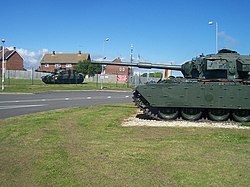| Lulworth Camp | |
|---|---|
| Purbeck Hills, Dorset | |
 Gate guardians at the entrance to Lulworth Camp | |
| Site information | |
| Type | Barracks |
| Owner | Ministry of Defence |
| Operator | |
| Location | |
| Coordinates | 50°38′00″N2°14′00″W / 50.63333°N 2.23333°W |
| Site history | |
| Built | 1918 |
| Built for | War Office |
| In use | 1918-Present |
Lulworth Camp is a British Army base that is home to the Armoured Fighting Vehicle Gunnery School and runs the Lulworth Ranges on the southern coast of Dorset, England. It is part of Bovington Garrison and is located on the Purbeck Ridge between the villages of East and West Lulworth. The camp lies immediately southeast of the road junction between the B 3070 and B 3071 and about a mile northeast of Lulworth Cove. [1]
